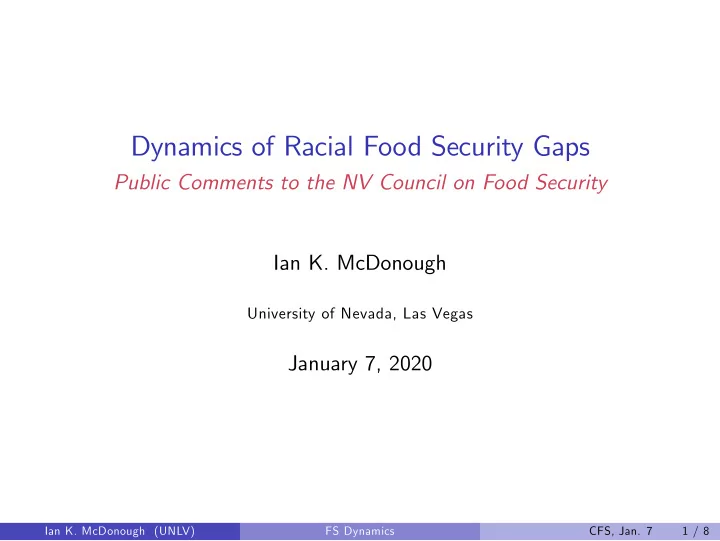

Dynamics of Racial Food Security Gaps Public Comments to the NV Council on Food Security Ian K. McDonough University of Nevada, Las Vegas January 7, 2020 Ian K. McDonough (UNLV) FS Dynamics CFS, Jan. 7 1 / 8
Disparity in FS Rates by Race/Ethnicity Well documented gap in food security rates by race/ethnicity National figures (Coleman-Jensen et al. 2019): � non-Hispanic White: ∼ 8 % � non-Hispanic Black: ∼ 21 % � Hispanic: ∼ 16 % While these figures and corresponding gaps are informative, we also need to understand underlying transition dynamics � i.e. food security mobility Ian K. McDonough (UNLV) FS Dynamics CFS, Jan. 7 2 / 8
What is meant by food security mobility? Food security distribution: � High food secure � Marginal food secure � Low food secure � Very low food secure Do households transition between states of food security over time, and do these transition dynamics differ along the dimension of race/ethnicity? Ian K. McDonough (UNLV) FS Dynamics CFS, Jan. 7 3 / 8
What is meant by food security mobility? As an example: Suppose you have data on household food security status over two time periods, t 0 and t 1 In t 0 you have 10 non-Hispanic white households classified as food insecure and 10 Hispanic households classified as food insecure In t 1 you have 5 of the non-Hispanic white households still classified as food insecure and 8 of the Hispanic households still classified as food insecure ⇒ Non-Hispanic white households have a 50% chance of transitioning upward to a better state of food security while Hispanic households only have a 20% chance of transitioning upward ⇒ This gap of 30 percentage points is one example of the gap in food security mobility The entire transition matrix (upward, downward, and staying probabilities) can be estimated Ian K. McDonough (UNLV) FS Dynamics CFS, Jan. 7 4 / 8
McDonough, Roy, and Roychowdhury (2019) Household-level data on food security from the Early Childhood Longitudinal Survey, Kindergarten Class of 1998—1999 study Food security status was assessed in four waves: spring kindergarten, spring third grade, spring fifth grade, and spring eighth grade USDA’s Core Food Security Module Results: � Hispanic and non-Hispanic white households with children seem to be equally mobile in the long run � Non-Hispanic black households with children tend to be less upwardly mobile and more downwardly mobile in food security status over time Ian K. McDonough (UNLV) FS Dynamics CFS, Jan. 7 5 / 8
McDonough, Roy, and Roychowdhury (2019) Fig. 1 Markov chain steady-state distributions, Black vs. White Ian K. McDonough (UNLV) FS Dynamics CFS, Jan. 7 6 / 8
McDonough, Roy, and Roychowdhury (2019) Fig. 2 Markov chain steady-state distributions, Hispanic vs. White Ian K. McDonough (UNLV) FS Dynamics CFS, Jan. 7 7 / 8
Final Comments Food security dynamics matter in addition to level-gaps in rates Understanding racial disparities in mobility patterns in food security status is important for the creation of effective policy � If mobility in food security is low for minority households relative to non-Hispanic white households, such that the minority households find themselves persistently food insecure, then policy should perhaps target the reduction in long term economic vulnerability (e.g. through acquisition of physical assets or human capital) of minorities. � If mobility is high across all households, and the racial food security gap is transitory–e.g. certain households do not have access to sufficient food for all members during periods of low income and volatile prices–then policy may be more effective if targeted towards sources of income/price volatility and/or credit and insurance markets. Ian K. McDonough (UNLV) FS Dynamics CFS, Jan. 7 8 / 8
Recommend
More recommend